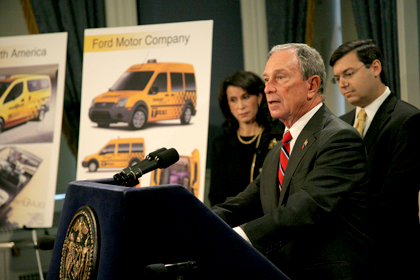
MAYOR BLOOMBERG & TAXI COMMISSIONER YASSKY ANNOUNCE THREE FINALISTS TO BE THE NEW, EXCLUSIVE NEW YORK CITY TAXICAB

The “Taxi of Tomorrow” will be First Ever Taxicab Custom Built for New York City
New Yorkers can Vote on the Features They Want in the Taxi of Tomorrow at NYC.GOV
Survey Participants have Chance to Win One Year of Free Taxi Rides
On November 15, 2010, Mayor Michael R. Bloomberg and Taxi and Limousine Commissioner/Chairman David S. Yassky unveiled the three finalists to be the new, exclusive New York City taxicab. The competition, called the “Taxi of Tomorrow,” will introduce the first ever custom built taxicab specifically designed for New York City. The Taxi of Tomorrow project includes a public input campaign where New Yorkers can vote for the features they want to see in the next New York City taxicab. The winning vehicle will be the exclusive New York City taxicab for a minimum of ten years and will be chosen from among several competitive proposals.
The three designs selected as the finalists to be the Taxi of Tomorrow are submissions from Ford Motor Company, Karsan USA and Nissan North America, Inc. The three finalists can be viewed at the Taxi of Tomorrow website located at www.nyc.gov, and New Yorkers can log on to the site to vote on the features they want in taxicabs. Survey participants will also be entered into a contest to win a year’s worth of free taxi rides. The Mayor announced the finalists in the Blue Room of City Hall where he was also joined by Katherine Oliver, Commissioner of the Mayor’s Office of Media and Entertainment, which designed the Taxi of Tomorrow website and the Public Service Announcement, and by Deborah Marton, Executive Director of The Design Trust for Public Space, the sponsor of the free taxi ride contest and a member of the Taxi of Tomorrow Stakeholder Committee.
“The yellow cab is one of the most iconic symbols of New York City,” said Mayor Bloomberg. “Taxis have been an important part of our mass transit network for more than a century and we are going to create a new taxi for our City that is safer, greener and more comfortable than the ones we have today. While the City has long set the standards for our taxis, including working to make our vehicles more fuel efficient, the City has never before worked with the auto industry to design one taxicab specifically for New York City until now. We want New Yorkers to take part in this process and tell us the features they want to see in the Taxi of Tomorrow.”
“There have been many visioning exercises involving forward thinking designs for futuristic, new taxicabs over the years,” said Commissioner Yassky. “This project marks the first time ever in the U.S. that such an exercise will be backed up by an automotive manufacturer that can turn these concepts into tangible reality and we are making the public a part of the process.”
“This dynamic new campaign is the result of a deep partnership between NYC Media and the Taxi and Limousine Commission which illustrates the impact of using media and technology and creative spirit to convey City messages,” said Commissioner Oliver. “We are excited to continue working with Commissioner Yassky and his entire team as New Yorkers give their feedback on the features they want to see in the Taxi of Tomorrow.”
“Taxis are the icon of our shared urban landscape, and for more than five years the Design Trust and Taxi and Limousine Commission have enjoyed an enormously productive collaboration to improve that icon culminating in the Taxi of Tomorrow,” said Design Trust for Public Space Executive Director Deborah Marton. “This project is about much more than getting from point A to point B. The Design Trust and Taxi and Limousine Commission are pioneering an accessible, sustainable, beautiful taxi that New Yorkers deserve. No other city in the U.S. has tried to do this, and we want to make sure every New Yorker has a chance to weigh in and be part of this historic event.”
Starting November 15, 2010, there will be a public service announcement running on the television screens in the back of every City taxicab to let passengers know about the Taxi of Tomorrow project and solicit their input.
The three finalists to be the Taxi of Tomorrow were selected from a larger group of submissions, and concepts were evaluated by the Taxi and Limousine Commission in cooperation with the Mayor’s Office for People with Disabilities and Ricardo, Inc., an international automotive engineering consulting firm. The winning proposal will be announced in early 2011 and the new vehicle will be on the road no later than the fall of 2014. Total fleet turnover will be gradual over several years as older vehicles retire. New York City taxicabs are typically retired after three to five years of service.
The Taxi of Tomorrow project began in 2007 with the formation of a Taxi of Tomorrow Stakeholder Committee, and a Request for Proposals was issued to automotive manufacturers in December 2009. The project seeks to build a taxicab that is safe, fuel efficient, accessible, durable, and comfortable.
New York City has 13,237 licensed taxicabs including the world’s largest fleet of fuel efficient taxicabs with 3,983 hybrid, 5 Compressed Natural Gas (CNG), and 17 clean diesel taxi cabs. Today’s taxi fleet is comprised of 16 different vehicles supported by nine manufacturers.
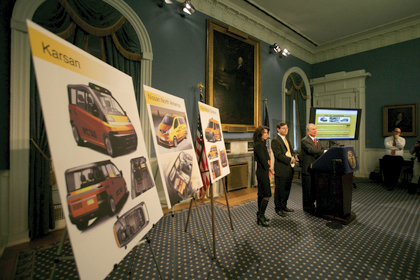
Mayor Bloomberg announces finalists to be the new exclusive New York City taxi cab for the next decade.
November 15, 2010 (Photo Credit: Edward Reed)
MAYOR, TLC ANNOUNCE 3 TOP CONTENDERS FOR THE TAXI OF TOMORROW, AND THE LAUNCH OF A WEBSITE TO SOLICIT PUBLIC INPUT
Complete the Taxi of Tomorrow survey. One lucky survey respondent will win free taxi rides for one year!
Sound too good to be true? It isn't. The Design Trust for Public Space is working with the Taxi and Limousine Commission to offer the chance to win free taxi rides for a year. To sign up, all you have to do is complete a quick survey about some of the things you're looking for in your Taxi of Tomorrow. To complete the survey and take your shot at a year of free taxis go to:
www.nyc.gov/html/media/html/contact/taxi_of_tomorrow_survey.shtml
In 2007, City officials convened a group of stakeholders, including representatives of taxi drivers, owner and passengers, to create a set of goals for the next New York City taxi cab, a project called the Taxi of Tomorrow. In December 2009, the TLC issued a “request for proposals” inviting auto manufacturers and designers to submit their best ideas for a purpose-built vehicle to serve as a New York City taxicab. Whichever of these designs that the City selects, if any, will be the next New York City taxica, bsubject to constant improvements and enhancements, for the next ten years.
After releasing a Request for Proposals (RFP) in late 2009, the City received a diverse group of proposals from automobile manufacturers, designers, and other interested parties offering what they believe would be the vehicle of the future. The TLC intends to select the best proposal and award an exclusive contract to sell and service taxicabs in New York for the next decade.
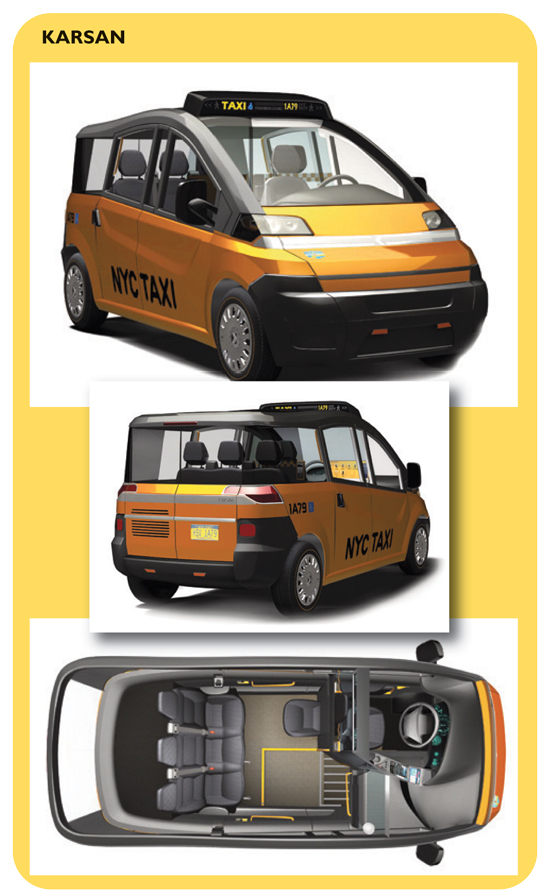
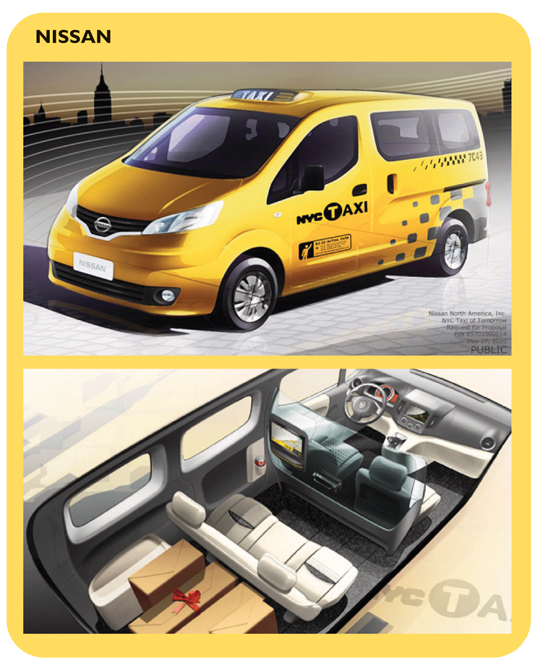
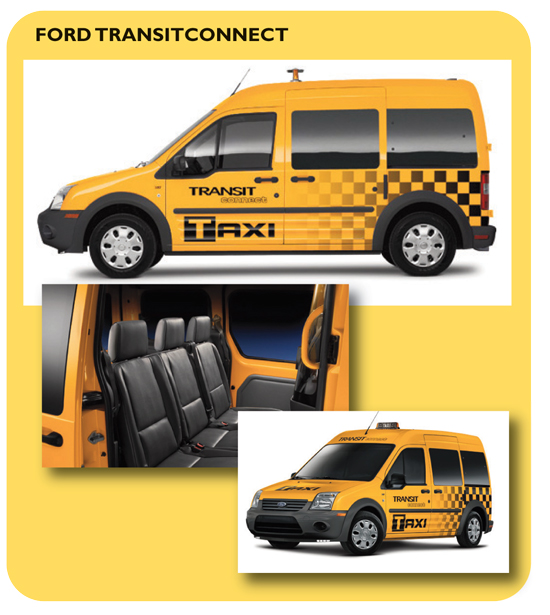
In 2010, most NYC taxicabs are Ford Crown Victoria sedans. The next most popular vehicle is the Ford Escape Hybrid. But there are many other models the City has approved that taxi medallion owners can choose to purchase such as the Toyota Camry, the Toyota Prius, the Saturn Vue Hybrid, the Toyota Highlander Hybrid, the Lexus RX400 Hybrid, the Chevrolet Uplander.
Today, most NYC taxicabs are Ford Crown Victoria sedans. When you think of a taxi today this is probably the car that comes to mind - a big, four door sedan. But there are also a lot of Ford Escape hybrid taxis, and several other models are approved for taxi use as well. Click here to tell us what you like and don't like about the taxis on the road today, and what features you'd most like to see in the Taxi of Tomorrow.
NYC taxis are owned by private companies and individuals, not by the City government. But the Taxi and Limousine Commission requires taxicab owners to select from a list of approved models. For more than a decade, the dominant vehicle in the City's taxi fleet was the gasoline powered Ford Stretch Crown Victoria. Beginning in October 2005, however, the TLC created a framework by which it allowed the inclusion of a variety of hybrid-electric models and wheelchair accessible cars to test their durability and performance. As of 2011, the Crown Vic won't be manufactured anymore, and the City needs to have an alternative that is durable, efficient, and good for passengers, drivers and owners.
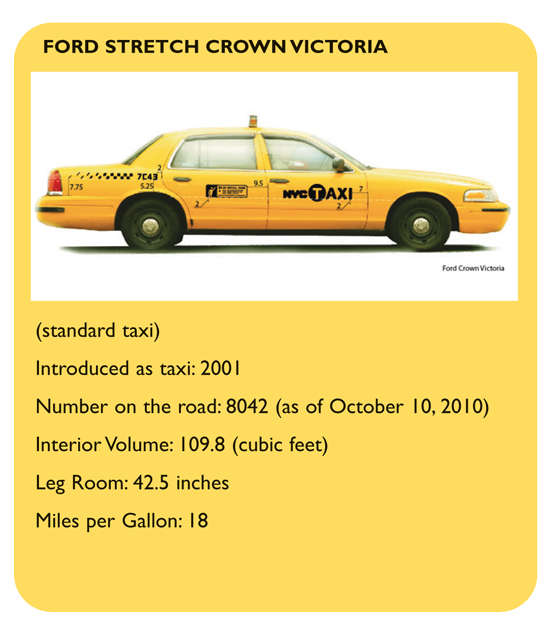
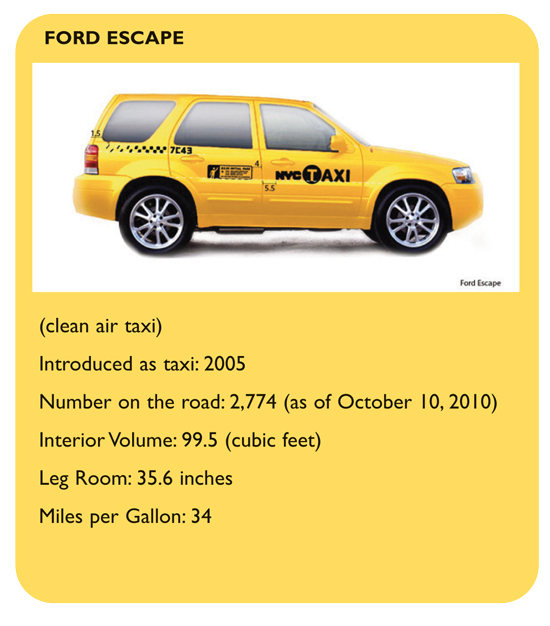
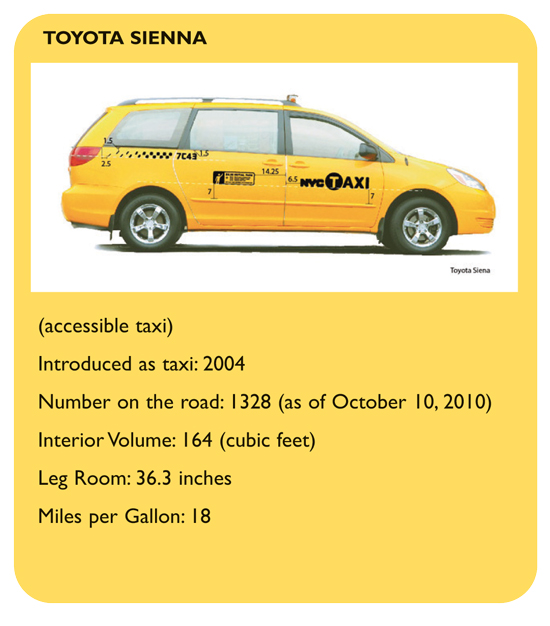
Since 1907, vehicles used as taxicabs have been an important part of NYC's transportation network. This section will provide information on the kinds of services provided and vehicles used in NYC over the last 103 years.
THE EARLY YEARS: 1907 - 1935
The New York City taxicab had humble beginnings. When the traditional metered, gasoline powered taxicabs began operating in October 1907, they were in tough competition with other forms of transportation throughout the city. Before the taxicab, New York City transit was dominated by a horse drawn carriage system. There were disadvantages to the horse drawn carriages, however. They were known to be slow, and they caused congestion throughout the City. Compounding this horses were dirty, difficult to maintain and sometimes downright dangerous to the public.
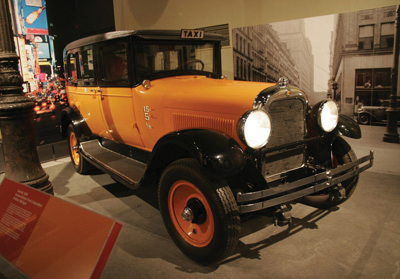
1929 NYC Taxi. Image courtesy of NYS Museum
By the turn of the 20th century New Yorkers were looking for an alternative to the archaic horse drawn carriage. Many new ideas were brought to the floor as entrepreneurs experimented with bicycle services and both electric and steam powered cars. One entrepreneur, Harry N. Allen, was able to successfully secure the significant funding necessary to import a fleet of 65 gasoline powered taxicabs from France where they were already extremely popular.
Despite the taxicab service’s early success and popularity the business faced legal disputes and labor unrest forcing it to fold within a few years. Even with the rapid rise of taxicabs there were some major problems in the taxicab industry including a lack of regulation. Because of taxis operated under few regulations there was little accountability and service was as varied as the number of fleets in operation. The presence of taxis on the road also contributed to a spike in car accidents and car related fatalities. The very first recorded traffic accident in New York City involved a taxicab.
Because of disputes between taxi drivers and fleet operators strikes were common. In one of the largest strikes of the taxicab industry’s early days, the Taxi Strike of 1934, taxi drivers went from peaceful protesters to angry rioters. They shut down the City and injured dozens of people.
In addition, taxicab drivers were not trusted by the public with some having had brushes with the law before they became taxi drivers. Taxis were considered by some New Yorkers to be a somewhat dangerous mode of transportation because passengers were never quite sure who was behind the wheel. Taxi drivers were also reputed to have acted as a gateway to the underworld of New York. During Prohibition, cab drivers were considered to have been among the most reliable sources of information on where to acquire alcohol and prostitutes. Some cabbies were even pimps secretly transporting pleasure seeking New Yorkers to brothels. Even with these problems, taxis were quickly becoming a part of New York life. There were several popular movies were made about taxi drivers during this period, and songs appeared that discussed the allure of a taxi ride.
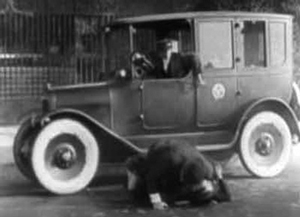
1922 Model C. Image courtesy of Coachbuilt.com
One song spoke of the intimacy and privacy that the back of a taxicab gave to love struck passengers. A verse of the song reads:
“They’ll never care he’s thinking of his little turtle dove
They only take a taxi when they’re in love, love, love”
In just 28 years, taxicabs rose from a little known mode of transportation to an influential part of New York life and transportation. Despite their newfound popularity and cultural acceptance, however, taxicabs still had a long way to go before becoming the icons they are today.
We appreciate and acknowledge the works of Dr. Gorman Gilbert and Robert Samuels (The Taxicab: An Urban Transportation Survivor) and Dr. Graham Russell Rao Hodges (Taxi! A Social History of the New York City Cabdriver), from which we gleaned certain facts.

(l to r) 1928 Model K. Photo courtesy of Coachbuilt.com, 1922 Model H2. Photo courtesy of Coachbuilt.com, 1922 Model H3. Photo courtesy of Coachbuilt.com.
REGULATION AND PROSPERITY: 1935 - 1960
Until 1935, the taxi industry in New York was comprised of unregulated companies fighting for dominance. This all changed during the Great Depression. Widespread poverty prompted many New Yorkers to opt for less expensive forms of transportation decreasing the demand for taxis. This put many companies out of business and caused many cabdrivers to lose their jobs. The situation was made worse by the tactics of “wildcat” (unlicensed) taxis who used what some considered to be “underhanded tactics” such as drastically lowering fares, to get more business.
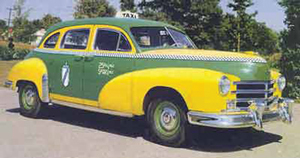
1954 Checker A6. Photo courtesy of Coachbuilt.com
The situation in the taxi industry was dire; frustrated cabdrivers turned their anger into violent protest and the demands for industry regulation increased. While regulation had already existed in some form with the Bureau of Licenses (aka the Police Department's “Hack Bureau”), many New Yorkers claimed that it was not enough. New York City's Board of Aldermen, the predecessor of the modern New York City Council, responded to calls for reform in 1937 by passing the Haas Act. The Haas Act established the medallion system for New York taxicabs which is still in use today. The Act's provisions included a limitation on the number of "medallion" licenses (and therefore, taxicabs) to the number that existed at the time. This number would be further reduced through attrition. As anticipated, this brought the supply of taxicabs closer to the level of service the public demanded thus calming the fierce competition for customers. The stability the Haas Act brought to the taxi industry laid the foundation for the later successes of the war and post war years.
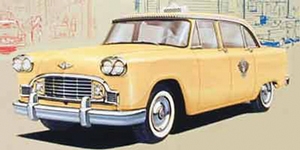
1959 Checker A92. Photo courtesy of Coachbuilt.com
A confluence of post Depression events helped the taxi industry in New York thrive. Facing the rationing of fuel and car parts during World War II, many turned to taxis for transportation. The resulting jump in demand helped the taxi industry grow as drivers no longer had to fight for business. Meanwhile, the value of medallions increased exponentially once license holders realized that they were indeed a transferable asset somewhat like real estate. While licenses cost $10 in 1937, medallions traded for an average $5,000 dollars in 1950. The profile of taxicab drivers also changed with an increase in women and African American drivers in the industry during and after the War.
During this period, several aspects of the modern day taxi began to emerge such as the popularity of the comfortable and stylish Checker taxicab. Checkers were immensely popular in the 1940s and 1960s and are considered an iconic part of vintage New York history. Perhaps, more importantly, the relationship between cabdriver and passenger began to take a more familiar shape. Cabdrivers no longer were thought of as people of dubious character, but instead were perceived as “an oracle, a counselor, a philosopher and an almanac," as Professor Graham Russell Gao Hodges wrote in his book, “Taxi! A Social History of the New York City Cabdriver”. Cabdrivers were seen as sources of advice and as experts on New York, an image bolstered by numerous movies and radio shows of the era. On occasion, cabbies were even seen as heroes who returned lost items and helped deliver babies.

(l to r) 1938 Checker. Photo courtesy of Coachbuilt.com; 1941 Checker M. Photo courtesy of Coachbuilt.com; 1939 Checker M4. Photo courtesy of Coachbuilt.com
In the 1960s, the success and prosperity of the taxi industry was challenged as some new problems emerged. One issue involved increasing incidences of reported driver discrimination in deciding whether to pick up a passenger which ostensibly stemmed from drivers’ safety concerns. Historians attribute the rising demand for "gypsy cabs" in boroughs outside of Manhattan to licensed taxi drivers' sometimes refusing service. The proliferation of these "gypsie cabs" soon caused confusion on the streets of New York as many people did not know a legal, licensed taxicab from an illegal unlicensed one.
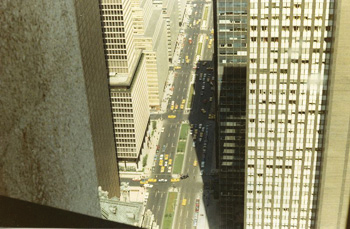
Taxis from Pan Am Building, 1967. Photo courtesy of John Atherton.
To decrease confusion between licensed and illegal taxis, City lawmakers created a requirement that all medallion taxicabs be yellow in the late 1960s, and created the NYC Taxi and Limousine Commission on March 2, 1971. These changes led to more consistent regulation of the medallion taxicab industry while also leading to the acknowledgement and legitimatization of what were then known as “gypsy cabs” into what are now known as livery cars, community cars, car services or for-hire vehicles. The 1970s also saw the taxi industry sub-divide yet again to give rise to the black car industry, which catered in large part to the corporate community. Despite all of the specialization furnished by the various newcomers to the for-hire world, yellow medallion taxicabs remain to this day the only vehicle legally authorized to respond to street hails.
The modern taxi also evolved in terms of its appearance. There were many makes and models over the years…Ford Galaxies, Plymouth Fury Threes, and of course the Checker.
While the last Checker taxicab was manufactured in 1982, TLC regulations allowed Checker owners to keep their iconic taxis on the road so long as they passed regular inspections. These regulations likewise allowed a handful of unique models such as Peugeot taxicabs to stay on the road “by virtue of their aesthetic appearance or historic status.”
By the mid-1990s, the Chevrolet Caprice was the workhorse of the taxi fleet with the balance tipping toward the Ford Crown Victoria when the discontinuation of the Caprice was announced in late 1996. At the same time, the number of Checker cabs that were left to carry on their powerful legacy had dwindled to a mere handful. By 1999, there were only two left, with their owners competitively racing to the finish line to see which one would retire first!
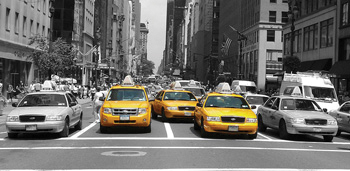
Photo courtesy of Ad Meskins
As it happened, there was only a month’s difference between them as Johann Struna’s Checker “3F89” was retired in May 1999 leaving Earl Johnson’s “1N11” at the finish line in June of that year. The Taxi and Limousine Commission celebrated the historic milestone with a party in the middle of Times Square, complete with a Checker cab-shaped cheesecake, courtesy of the famed Junior’s restaurant in Brooklyn. In a postscript to this bit of history, Mr. Johnson’s last final remaining iconic Checker taxicab was auctioned by Sotheby’s for $134,500 in November 1999.
In November 2001, mindful of the public’s wish for a more comfortable ride, the TLC and Ford together announced the creation of a “stretched” version of the Crown Victoria which added seven inches to the size of the chassis…six inches of which went to the passenger, and one to the driver. In the meantime, the NYC taxi fleet also featured a small number of minivan taxicabs, and even a few Ford Explorers. After some initial concerns about the lack of legroom in hybrid-electric vehicles, in late 2005 the TLC approved the inclusion of all commercially available hybrid models in the taxicab system.
A small number of new taxicab medallion licenses were auctioned between 2003 and 2008, including a percentage of licenses earmarked for use only by alternative fuel vehicles or by wheelchair-accessible vehicles.
These environmentally superior vehicles were found to hold up nicely, despite the rigors of city driving. While legal challenges ultimately thwarted the City’s efforts to mandate conversion of the entire taxicab fleet to hybrids, the TLC is proud that today’s taxicab fleet is over 30% hybrid with the majority having been “hacked up” voluntarily by owners and operators who valued their many benefits. The New York City taxicab industry boasts the highest number of both wheelchair-accessible taxicabs and hybrid-electric taxicabs in the nation.
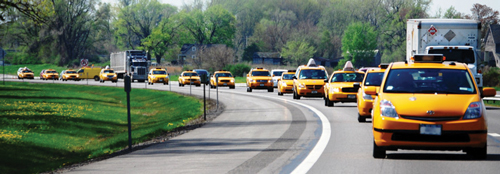
NYC Taxis take to the highway. Photo courtesy of LOMTO.
by Phil Patton, Courtesy of The Design Trust for Public Space
The New York City taxicab is almost as famous as the city it serves having been immortalized in film, literature and music throughout its relatively brief existence. Here are a few examples.
The taxicab is a symbol of New York to millions of tourists. It marks arrival and departure—the modern equivalent of a city gate. It is the space of entrance to the city. It frames the visitor’s first glances.
Great cities are symbolized by structures and spaces, bridges and domes and towers, rivers and boulevards and plazas. Think of the Eiffel Tower, St. Peter’s or St. Paul’s, the Golden Gate or the Brooklyn Bridge. But they are also symbolized by their subways, buses, and taxis. As much as by Big Ben, London is symbolized by its red double-decker busses, its red phone booths and its black taxis. Just as much as it is represented by its piers or subways, by the same token, New York is symbolized by its taxis.
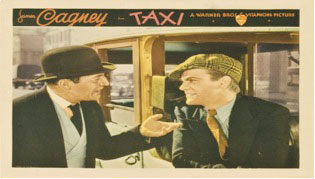
A poster from the 1932 movie, Taxi. In the film, a taxi driver takes on his corrupt fleet manager.
Taxis on Film
New York is probably the most filmed city in the history of Hollywood, and no New York movie would be complete without some mention of a taxicab. Whether in a cameo appearance or a starring role, New York City taxis have always had a place on the silver screen.
In the film Taxi (2005), a re-imagining of a French movie by the same name, a mouthy cabdriver played by Queen Latifah helps inept cop Jimmy Fallon solve a string of New York City bank robberies committed by a quartet of female Brazilian bank robbers. The NYC TLC helped plan the movie's premiere event at the Jacob Javits Convention Center which featured almost 200 taxicabs enjoying the film on a massive indoor “drive-in” screen. The premiere's red carpet featured dozens of the world's most recognizable celebrities.
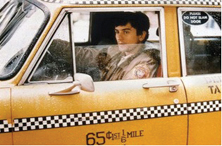
A scene in the Oscar-nominated film Taxi Driver. In this film a Vietnam veteran taxi driver copes with his own internal demons and the crime and corruption in the City's streets.
Just a few of the movies known for featuring the New York taxicabs include: On the Town, Taxi Driver, Taxi (1932), Taxi (2005), Stuart Little, Ghostbusters, Scrooged, Home Alone 2, Side Street, Breakfast at Tiffany's, Escape from New York, City Hall, The Bone Collector, Conspiracy Theory, The Fifth Element, Superman, Superman II, Annie Hall, and Enchanted.
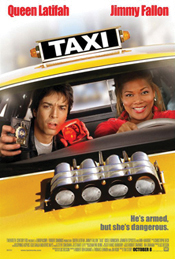
A poster for the comedy Taxi.
Taxis on TV
As with film, New York City has been the setting for many television shows involving taxicabs. The most famous of these was the situation comedy Taxi which originally aired from 1978 to 1982 on ABC, and from 1982 to 1983 on NBC. Aside from launching the careers of actors Judd Hirsch, Danny DeVito, Tony Danza, Christopher Lloyd, Marilu Henner and Jeff Conaway, it included controversial up-and-coming comedy star Andy Kaufman. The series won 18 Emmy Awards, and focused on the everyday lives of a handful of New York City taxi drivers and their charismatically abusive dispatcher.
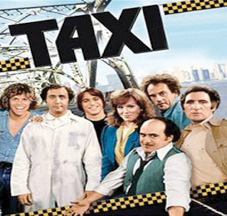
Other familiar shows included Hack which starred character actor David Morse (also known for The Green Mile and a popular run of episodes on the hit Fox drama House).
In a plotline on the situation comedy Friends, the character Phoebe spent some time behind the wheel of a Checker cab when her aunt bequeathed her one in her will.
Taxis in Literature
Taxis have also been the focus of many books and poems. Taxis have made appearances in books such as The Great Gatsby and Catcher in the Rye. Poems have also been written to express the effects taxis have on people and society.
Taxis in Song
Taxis have also become iconic through music. Over the past few decades some of the biggest names of music have written about the taxicab, usually as part of a song for their love of New York City. Here are a few examples: